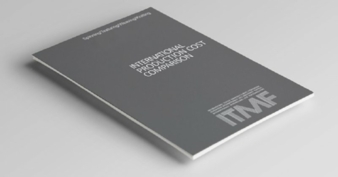27/06/2022 – IPCC report
Tracing production costs in the primary textile industry
The new edition of the International Production Cost Comparison (IPCC) from ITMF has been published. The report measures the manufacturing costs of different textile products in the primary textile industry.
The 2021 edition adds Central America and Mexico to the historical cost analysis in Bangladesh, Brazil, China, Egypt, India, Indonesia, Italy, Korea Rep., Pakistan, Turkey, USA, and Vietnam. Cost factors, manufacturing costs and total production costs are available for different textile products in the segments of spinning, draw texturing, weaving, knitting, and finishing.
For example, the publication reveals that producing one meter of woven fabric from cotton 1-1/8" in a continuous open width process (COW) cost 1.36 USD/m on average in 2021 (see Figure 1, range between 1.11 UDS/m in India and 1.91 USD/m in Italy).
Spinning the yarn needed to produce this meter of a finished woven fabric costs 19% of the fabrics’ total production cost on average worldwide (range between 15% in Korea, Rep. and 22% in Central America). Weaving this yarn adds an extra 19 percentage points (pp) on average to the total production cost of the fabric (range between 14 pp in Egypt and 26 pp in Italy). Finally, finishing this meter of woven fabric increases the final production cost by 31 pp (range between 26pp in Egypt and 33pp in the U.S.A., Turkey, and India).
The study further reveals that the average cost of raw materials needed to produce this meter of woven fabric was 31% of the fabric’s production cost. It was relatively cheaper in Italy (22%) and most expensive in Egypt (40%).
The publication also shows that Mexico and Central America are comparatively more dependent on energy cost for spinning NE/30 yarn then the other countries in the panel. The cost of power represents 28% and 25% of manufacturing costs in both countries, respectively. In contrast, the U.S.A, and Egypt benefit from relatively low energy costs (10% and 11% of manufacturing costs, respectively). Dependency on labor costs is very high in Italy and the U.S.A with shares of 40% and 38% of manufacturing costs. This cost element represents only 2% to 3% of total manufacturing costs in India, Pakistan, Bangladesh, and Egypt. Spinners of NE/30 yarn in Egypt, Central America and Pakistan further face high capital cost (over 40% of their manufacturing costs). The cost of capital is much lower in Italy and Korea, Rep., where it reached 21% in 2021.
Find more about this extensive study on www.itmf.org/publications.




